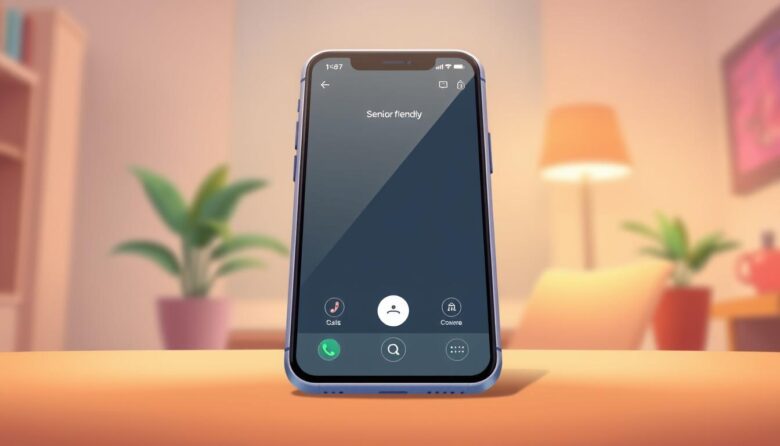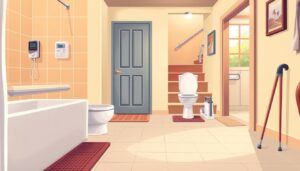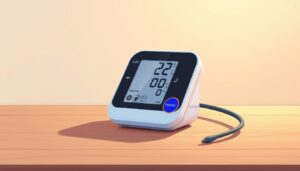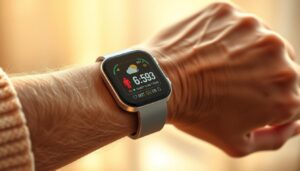Modern smartphones can feel overwhelming, but simplified settings make technology accessible for everyone. Whether you’re helping a loved one or adjusting your own device, specialized tools create a stress-free experience. These adjustments prioritize clarity with larger text, bold icons, and streamlined menus.
Many devices offer built-in solutions to reduce accidental touches or unwanted actions. Features like enhanced screen locks and contact safeguards add peace of mind. You’ll also find options to prioritize essential functions while minimizing distractions.
This guide shows how to transform any compatible phone into a user-friendly tool. We’ll focus on practical steps for adjusting display layouts, optimizing home screens, and configuring emergency shortcuts. Special attention is given to popular models with unique accessibility tools.
By the end, you’ll know how to balance simplicity with functionality. Protect against common frustrations while maintaining access to important apps and services. Let’s create a setup that feels intuitive and secure.
Introduction to Simplified Navigation for Seniors
Age shouldn’t limit someone’s ability to use communication tools effectively. Many older adults feel frustrated by complex menus and touch-sensitive screens designed for tech-savvy users. Small text sizes and crowded layouts often lead to accidental taps or confusion.
Common struggles include difficulty reading notifications or locating essential apps. Some avoid using their devices altogether due to fear of making irreversible errors. This hesitation can create isolation, making it harder to connect with loved ones or access vital services.
A tailored interface transforms this experience. Enlarged buttons, simplified app grids, and intuitive controls restore confidence in daily use. When devices match their users’ needs, older adults gain independence while staying engaged with their communities.
Thoughtful adjustments also reduce cognitive overload. Streamlined layouts focus on core functions like calling, messaging, and emergency alerts. This approach minimizes distractions while maintaining access to helpful features.
By prioritizing clarity over complexity, you create a tool that feels welcoming rather than intimidating. The right setup empowers users to embrace technology without anxiety, fostering meaningful connections and practical support.
Understanding Easy Mode and Its Benefits
Smartphone interfaces don’t need to confuse users with endless options. Specialized display settings transform cluttered screens into organized spaces. By prioritizing core functions, these adjustments help users navigate devices without frustration.
Activating simplified layouts increases visual clarity significantly. Icons triple in size, menus shrink to essential choices, and text becomes bold enough to read at arm’s length. Samsung’s solution, for example, replaces tiny app labels with clear buttons arranged in logical groups.
This streamlined approach minimizes accidental screen taps. Buttons gain spacing to accommodate less precise touches, while lock screens require deliberate gestures to activate. The result? A forgiving interface that reduces stress during daily use.
Standard smartphone modes often overwhelm with notifications and nested menus. Simplified versions strip away distractions, leaving only calling, messaging, and emergency tools upfront. Third-party launchers like Elder Launcher take this further, offering customizable grids that adapt to individual needs.
With fewer visual distractions, users focus better on tasks that matter. Important contacts stay visible, and settings menus shrink to critical options. This thoughtful design builds confidence, letting people enjoy technology rather than fear it.
How to Enable easy mode Android for seniors
Customizing your device’s interface requires just a few adjustments. Most manufacturers include built-in tools to simplify menus and layouts. We’ll focus on Samsung’s approach as a common example for streamlined setup.
Overview of the Setup Process
Open your settings menu and select “Display.” Choose the simplified layout option – often labeled clearly for quick access. Tap the toggle to activate the new view. Your home screen will refresh instantly with larger icons and simplified labels.
This step typically preserves your existing apps while reorganizing their placement. Essential tools like phone and messages move front-and-center. Third-party applications remain accessible through a consolidated menu.
Key Differences from Standard Mode
The updated screen layout increases icon size by 30-50% for better visibility. Text becomes bolder, with adjustable font options under display preferences. Navigation buttons grow more prominent, reducing accidental taps.
Menus show only critical functions, hiding advanced features behind a “More” tab. Notifications appear less frequently, and app grids use spacious rows. If the simplified view feels too limited, you can revert changes in three taps.
Having trouble finding the option? Restart your device and check for software updates. Some models require latest OS versions to access these settings.
Step-by-Step Setup for Easy Mode Activation on Android
Transforming your device starts with locating the right settings. Open your app drawer and tap the gear-shaped icon labeled “Settings.” Scroll to the “Display” section – this houses the tools to overhaul your screen layout.
Select “Display” and look for the simplified view option. On Samsung devices, this appears as a toggle switch labeled clearly. Activate it with one tap – your system will refresh instantly. Expect larger app icons and cleaner menus immediately.
Different manufacturers place this feature in varying locations. LG users often find it under “Home Screen” settings, while Motorola devices may label it “Simple Mode.” Check your brand’s support page if the option seems hidden.
Confirm successful activation by returning to your home screen. You should see essential apps like Phone and Messages prominently displayed. Secondary applications move to a consolidated menu for access when needed.
If changes don’t appear, restart your device. This step resolves most display glitches. For persistent issues, ensure your operating system runs the latest updates through Settings > Software Update.
Enhancing Display Settings for Better Readability
Clear visibility transforms how we interact with devices every day. Optimizing your display settings creates crisp, easy-to-read content without straining your eyes. Let’s explore adjustments that turn cramped text into comfortable reading experiences.
Adjusting Text and Font Size
Open your device’s settings and select “Display.” Tap “Font size and style” to reveal a sliding scale. Drag the indicator rightward to enlarge text size across menus, apps, and notifications. Many find a 120-130% increase ideal for reading at arm’s length.
Enable bold formatting here for sharper letter edges. This simple tweak adds contrast between characters and backgrounds. Test different font styles – some options like “Roboto Bold” improve clarity better than others.
Customizing Display Options for Clarity
Return to the main display menu to adjust brightness and color balance. Automatic brightness often works poorly in direct sunlight. Set manual levels that keep screen content visible without glare. Enable “Dark mode” if white backgrounds cause eye fatigue.
High contrast themes make buttons and icons stand out clearly. Pair these with grid-based app layouts to reduce visual clutter. Remember – larger font sizes might require scrolling more often. Balance readability with practical navigation needs.
Configuring Home Screen Layout and Icon Size
Your device’s home screen serves as the command center for daily tasks. Start by keeping only essential apps visible – phone, messages, and camera work well upfront. Long-press unused icons and drag them to the “Remove” option to declutter the space.
Rearrange remaining icons by holding and sliding them into logical groups. Place frequently used tools near the bottom half of the screen for easier thumb access. This positioning reduces strain during one-handed use.
Combine related applications into folders for better organization. Tap and hold an app, then drag it onto another to create labeled groups like “Health” or “Connections.” These collections prevent endless scrolling through disorganized menus.
Adjust icon size through your display settings for improved visibility. Larger buttons minimize accidental taps while making labels easier to read. Most devices let you scale elements up to 150% without affecting functionality.
Test your layout by navigating key functions with eyes closed. If you can locate core tools through muscle memory, you’ve achieved an intuitive setup. Regularly update the home screen as needs change, maintaining simplicity as new apps get added.
Activating Safety Features and Accidental Touch Protection
Security becomes crucial when adapting devices for comfortable use. Many unintentional taps occur when screens respond to light brushes or misplaced fingers. Built-in safeguards help prevent these mishaps while maintaining full access to essential functions.
Enabling Accidental Touch Protection
Navigate to your settings menu and select “Display.” Locate the toggle labeled “Accidental touch protection” – this feature ignores light taps when your device isn’t in active use. Activate it to reduce phantom screen interactions during pocket storage or casual handling.
Turning on Auto Blocker for Security
Strengthen your system defenses through Security and Privacy settings. Choose “Auto Blocker” to restrict app installations to trusted sources like official stores. This feature also blocks suspicious images in messages and prevents unauthorized USB commands.
These layers of protection work seamlessly together. You maintain access to core apps while minimizing risks from external threats. Regular software updates keep these safeguards effective against evolving digital risks.
Setting Up Emergency Contacts and Speed Dial
Quick access to help becomes essential when every second counts. Your device’s Emergency Contacts feature lets loved ones receive instant alerts during crises. Press the power button three times to activate this lifeline – it automatically sends a 5-second audio clip and photos from both cameras.
Navigate to Settings > Safety and Emergencies to configure these options. Select “Add Member” and pick trusted individuals from your contacts. Enable “Show on Lock Screen” so first responders see critical information immediately, even without unlocking the device.
Create multiple emergency connections for layered support. Each chosen contact receives real-time location data alongside visual alerts. Test the system afterward by performing a practice trigger – confirm recipients get all details correctly.
Simplify frequent calls with speed dial shortcuts. Assign key numbers to specific digits in your Phone app settings. A long press on “2” could instantly connect to a family member, while “3” might reach a healthcare provider.
Regularly update these settings as relationships or needs change. Pair emergency features with clear verbal instructions for maximum effectiveness during stressful situations. This preparation turns your device into a reliable safety companion.
Organizing Apps and Widgets for a Clutter-Free Interface
A well-organized device puts essential tools at your fingertips while reducing visual chaos. Start by reviewing apps on the home screen – remove rarely used ones through long-press and drag-to-uninstall. Focus on keeping only daily essentials like calls, messages, and health trackers visible.
Group remaining tools by purpose for intuitive access. Create labeled folders like “Connections” for communication apps and “Utilities” for calculators or flashlights. Position these clusters in the central area of your screen where thumbs naturally reach.
Enhance functionality with strategic widgets. Add a weather forecast panel or medication reminder tile to the home screen’s top section. These visual aids provide instant information without opening multiple apps.
Prioritize placement based on usage frequency. Move favorite tools to the dock area for constant visibility. Less-used items can reside in secondary folders or app drawers. This hierarchy creates a logical flow that matches natural navigation patterns.
Secure your layout by saving it as a custom theme. Most devices let you back up home screen configurations through settings. If accidental changes occur, restore your preferred setup in seconds.
Utilizing Senior-Friendly Launchers and Custom Interfaces
Custom interfaces can revolutionize how loved ones interact with their devices. Specialized launchers like Elder Launcher replace complex menus with bold grids of oversized icons. These tools magnify text and buttons beyond standard settings, helping users with limited vision navigate confidently.
Elder Launcher stands out by letting families handpick essential apps for the interface. Contacts become large, tappable tiles with instant calling. BaldPhone takes this further, offering voice-guided menus and emergency alerts. Big Launcher simplifies messaging with pre-written responses for quick replies.
Installing these solutions takes minutes. Download your chosen app from trusted stores, then set it as the default home screen through device settings. Most android phones allow reverting to the original layout anytime if preferences change.
Compare options based on specific needs – some prioritize medical reminders, while others focus on photo-sharing simplicity. The right choice turns everyday phones into empowering tools that match individual capabilities.



